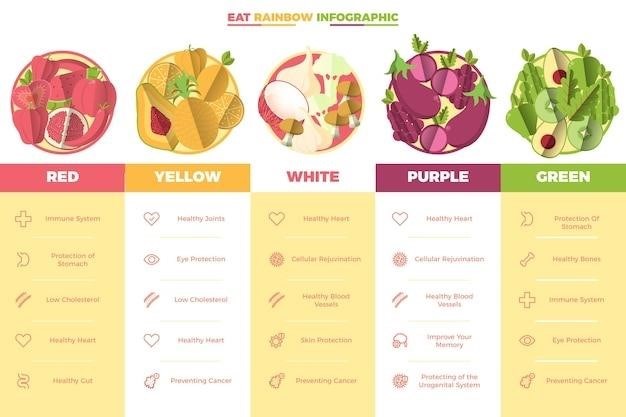Low-Fat Foods⁚ A Comprehensive Guide
This comprehensive guide provides information about low-fat foods, including their benefits, types, meal planning tips, and a list of specific low-fat food options․ It explores the importance of a low-fat diet and offers practical advice on making healthy choices․ This guide serves as a valuable resource for individuals seeking to understand and incorporate low-fat foods into their diet for improved health and well-being․
Introduction
In the realm of nutrition, the concept of “low-fat” has been a subject of ongoing debate and discussion․ While the focus on fat reduction has been a cornerstone of dietary recommendations for decades, recent research has shed light on the complexities of fat intake and its impact on health․ This guide aims to provide a comprehensive overview of low-fat foods, offering clarity on their benefits, types, and how to incorporate them into a balanced diet․ We will delve into the science behind low-fat eating, exploring its potential advantages and limitations․ Furthermore, we will provide practical tips for choosing low-fat options, creating balanced meal plans, and navigating the vast array of food labels that often mislead consumers․
This guide aims to empower individuals with the knowledge and tools to make informed decisions about their dietary choices, ultimately promoting a healthy and sustainable lifestyle․ It is not intended to replace professional medical advice․ Consult with a healthcare professional or registered dietitian for personalized guidance tailored to your individual needs and health conditions․
Understanding Low-Fat Foods
The term “low-fat” refers to foods that contain a reduced amount of fat compared to their full-fat counterparts․ However, it’s crucial to understand that “low-fat” doesn’t necessarily equate to “healthy․” The key is to focus on consuming healthy fats, such as those found in olive oil, avocados, nuts, and fatty fish, while limiting unhealthy fats, like saturated and trans fats․ These unhealthy fats can contribute to heart disease, high cholesterol, and other health problems․
Low-fat foods often have reduced calories, which can be beneficial for weight management․ However, some low-fat products may contain added sugars or other ingredients to compensate for the lack of flavor, potentially negating their health benefits․ It’s essential to read food labels carefully and choose options that are low in both fat and added sugar․
When selecting low-fat foods, consider factors like nutritional content, processing methods, and overall dietary balance․ A balanced diet should include a variety of nutrient-rich foods, including fruits, vegetables, whole grains, lean protein sources, and healthy fats․
Benefits of a Low-Fat Diet
A low-fat diet can offer several potential health benefits, particularly when it comes to heart health․ By reducing the intake of saturated and trans fats, a low-fat diet can help lower cholesterol levels, which can reduce the risk of heart disease, stroke, and other cardiovascular problems․ Furthermore, a low-fat diet may help manage weight, as fat is calorie-dense, and reducing fat intake can lead to a lower calorie intake overall․
Some research suggests that a low-fat diet may also help reduce the risk of certain types of cancer, including breast cancer and colorectal cancer․ However, more research is needed to confirm these findings․ Additionally, a low-fat diet may improve blood sugar control, which can be beneficial for individuals with diabetes or pre-diabetes․ This is because low-fat foods tend to have a lower glycemic index, meaning they don’t cause rapid spikes in blood sugar levels․
While a low-fat diet can offer potential benefits, it’s essential to remember that it’s just one component of a healthy lifestyle․ Combining a low-fat diet with regular exercise, stress management, and adequate sleep can significantly enhance overall health and well-being․
Types of Low-Fat Foods
Low-fat foods encompass a wide variety of options across different food groups, ensuring a balanced and diverse diet․ Fruits and vegetables are naturally low in fat and are excellent sources of vitamins, minerals, and fiber․ Lean protein sources, such as chicken breast (without skin), turkey breast, fish, and beans, provide essential protein without excessive fat content․ Grains and legumes, including whole grains like brown rice, quinoa, and oats, as well as lentils and chickpeas, offer complex carbohydrates, fiber, and other nutrients․ Dairy products, such as skim milk, low-fat yogurt, and fat-free cheese, are good sources of calcium and protein while being lower in fat․
It’s important to note that not all low-fat foods are created equal․ Some low-fat options may be high in sugar, sodium, or processed ingredients․ Therefore, it’s crucial to read food labels carefully and choose options that are minimally processed and low in added sugar and sodium․ By incorporating a variety of low-fat foods from different food groups, you can create a balanced and healthy diet that supports overall well-being․
Fruits and Vegetables
Fruits and vegetables are naturally low in fat and are foundational components of a healthy low-fat diet․ They are packed with essential vitamins, minerals, fiber, and antioxidants, providing numerous health benefits․ Most fruits and vegetables, with the exception of olives and avocados, are naturally low in fat, making them ideal choices for a low-fat meal plan․ Fresh, frozen, and canned fruits and vegetables are all good options, providing a wide range of flavors, textures, and nutritional profiles․
Fruits and vegetables can be incorporated into meals and snacks in various ways․ They can be enjoyed raw, steamed, roasted, grilled, or added to salads, smoothies, and other dishes․ By incorporating a variety of fruits and vegetables into your diet, you can ensure that you are getting a wide range of nutrients and supporting your overall health and well-being․ Remember to choose low-sodium canned vegetables to minimize sodium intake․
Lean Protein Sources
Lean protein sources are essential for maintaining muscle mass, supporting satiety, and providing essential nutrients․ When choosing lean protein sources, prioritize options that are naturally low in saturated fat and cholesterol․ Chicken and turkey breast, without the skin, are excellent choices, offering a flavorful and versatile protein source․ Ground turkey breast is another lean option that can be used in various recipes, providing a healthier alternative to ground beef․ Fish, particularly fatty fish like salmon, tuna, and mackerel, are rich in omega-3 fatty acids, which are beneficial for heart health․ These fish can be enjoyed grilled, baked, or poached to minimize added fat․
Plant-based protein sources are also excellent choices for a low-fat diet․ Beans, lentils, tofu, and tempeh are good sources of protein and fiber, contributing to a feeling of fullness and supporting digestive health․ These plant-based proteins can be incorporated into salads, soups, stews, and stir-fries, adding both flavor and nutritional value․ Eggs are a good source of protein and other essential nutrients, and while they contain some fat, they can be enjoyed as part of a balanced low-fat diet․ When preparing eggs, choose methods like poaching or scrambling without added fat, and limit the consumption of fried eggs․
Grains and Legumes
Grains and legumes are excellent sources of fiber, complex carbohydrates, and essential nutrients, making them valuable additions to a low-fat diet․ Whole grains, such as brown rice, quinoa, oats, and whole-wheat bread, provide sustained energy and contribute to digestive health․ When choosing bread, opt for whole-wheat varieties, as they contain more fiber and nutrients compared to white bread․ Avoid processed grains, such as white rice, white bread, and refined cereals, as they are often low in fiber and nutrients and can contribute to blood sugar fluctuations․
Legumes, including beans, lentils, chickpeas, and peas, are excellent sources of protein, fiber, and various vitamins and minerals․ They are naturally low in fat and can be incorporated into a variety of dishes, adding both flavor and nutritional value․ Beans and lentils can be used in soups, stews, salads, and vegetarian chili, providing a hearty and satisfying protein source․ Choose canned beans and lentils that are labeled “low sodium” or “no salt added” to minimize sodium intake․
Dairy Products
Dairy products, such as milk, yogurt, and cheese, can play a role in a low-fat diet, but it’s essential to choose low-fat or fat-free options․ Skim milk and fat-free yogurt are excellent sources of calcium and protein without the added fat․ Greek yogurt is a particularly good choice, as it is higher in protein and lower in carbohydrates compared to regular yogurt․ Look for plain yogurt and add your own fruit for natural sweetness instead of opting for flavored varieties, which can be high in sugar․
When it comes to cheese, choose low-fat or fat-free varieties․ Cottage cheese is naturally low in fat and a good source of protein․ However, be mindful of the sodium content in some cheese varieties, as it can be high․ If you enjoy cheese, incorporate it in moderation as part of a balanced diet․ Consider using cheese sparingly as a topping for salads, vegetables, or whole-grain crackers․ Remember, moderation is key when incorporating dairy products into a low-fat diet․
Creating a Low-Fat Meal Plan
Creating a low-fat meal plan involves making strategic choices to minimize fat intake while ensuring adequate nutrition․ Start by focusing on lean protein sources like chicken breast, fish, beans, and tofu․ Incorporate plenty of fruits and vegetables, which are naturally low in fat and rich in vitamins, minerals, and fiber․ Whole grains, such as brown rice, quinoa, and oats, provide complex carbohydrates and fiber, contributing to a feeling of fullness and aiding in blood sugar regulation․
When cooking, prioritize healthy cooking methods like grilling, baking, steaming, and stir-frying over deep frying․ Use low-fat cooking sprays or olive oil in moderation to enhance flavor․ Pay attention to portion sizes, as even low-fat foods can contribute to calorie intake if consumed excessively․ Plan your meals ahead of time to avoid impulsive choices and ensure you have healthy options readily available․
Tips for Choosing Low-Fat Foods
Navigating the grocery store can be tricky when trying to select low-fat options․ Always check food labels carefully, looking for the “fat” content listed per serving․ Aim for foods with less than 3 grams of fat per 100 grams․ Look for labels that highlight “low-fat,” “fat-free,” or “reduced fat” for added assurance․ Be aware that some “low-fat” options may be high in sugar or other unhealthy ingredients to compensate for the reduced fat content․
Choose fresh fruits and vegetables over processed snacks and fast food, as they are naturally low in fat and high in nutrients․ Opt for lean meats and poultry, trimming visible fat before cooking․ When choosing dairy products, select low-fat or fat-free varieties․ Be mindful of hidden fats in sauces, dressings, and baked goods․ Choose plain yogurt and add your own fruit for a healthier option․

Incorporating low-fat foods into your diet can contribute to a healthier lifestyle․ By making informed choices and understanding the benefits of a low-fat approach, you can create a balanced and nutritious eating plan․ Remember, a low-fat diet is not about eliminating all fat, but rather focusing on healthy fats while reducing the consumption of unhealthy saturated and trans fats․ A balanced diet that includes a variety of low-fat foods can promote overall well-being, improve heart health, and contribute to weight management․
This guide provides a foundation for understanding and implementing a low-fat lifestyle․ It encourages you to explore various low-fat food options, learn about their benefits, and make informed decisions when selecting food items․ Ultimately, a low-fat diet can be a positive step towards a healthier you․
